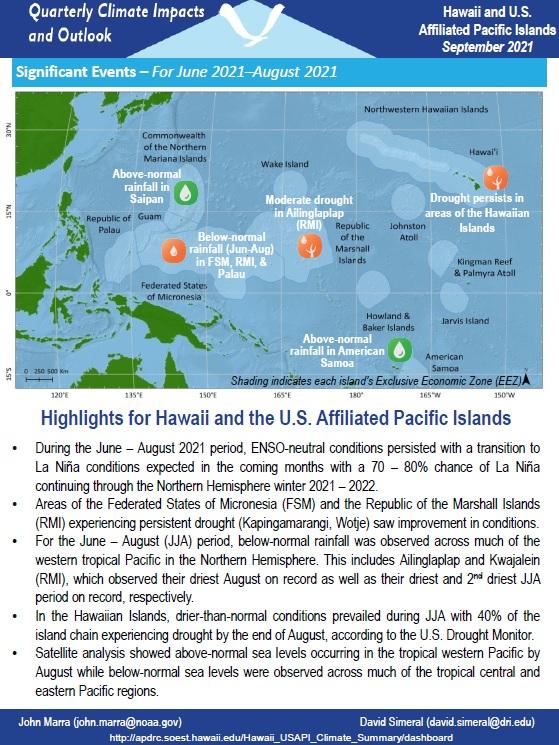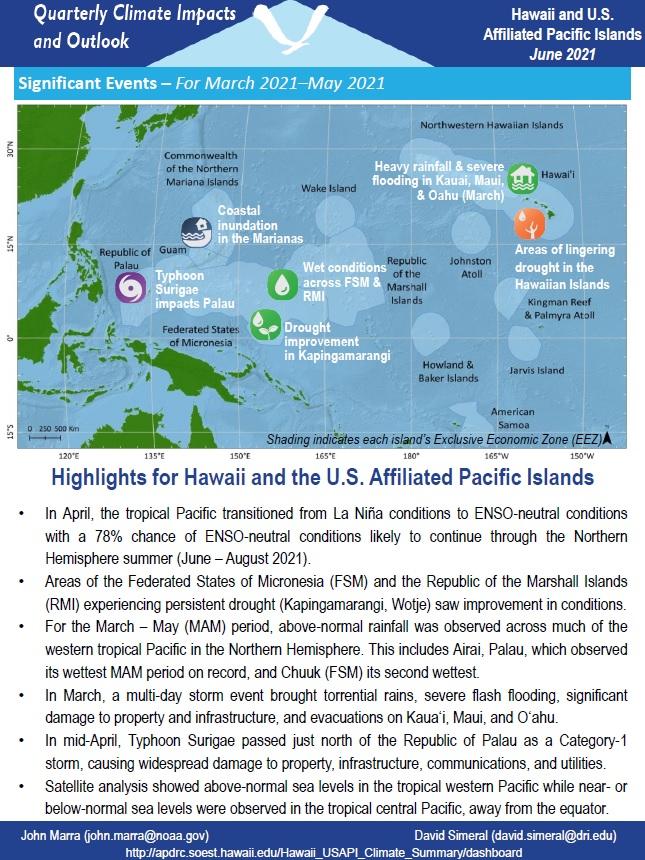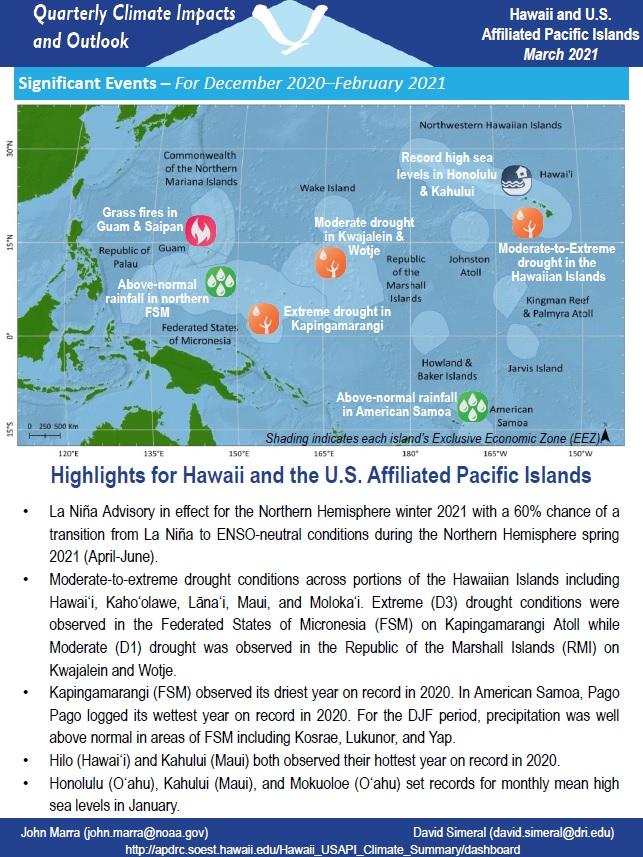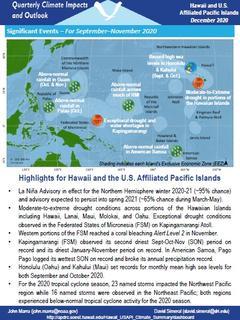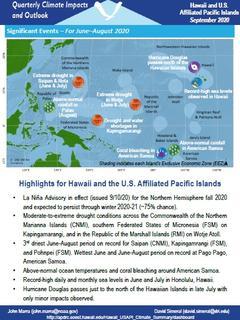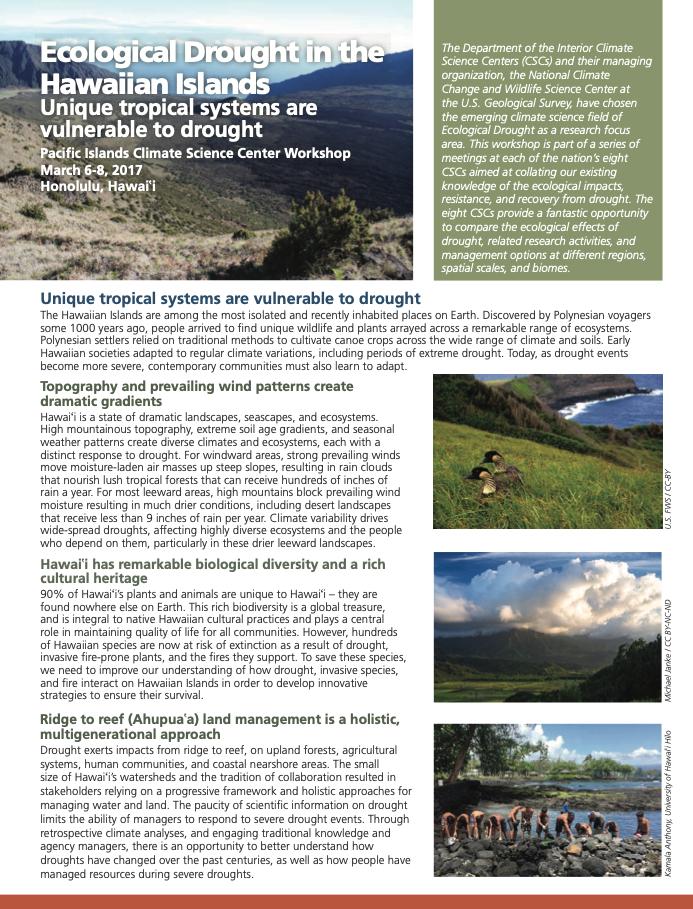U.S. Affiliated Pacific Islands
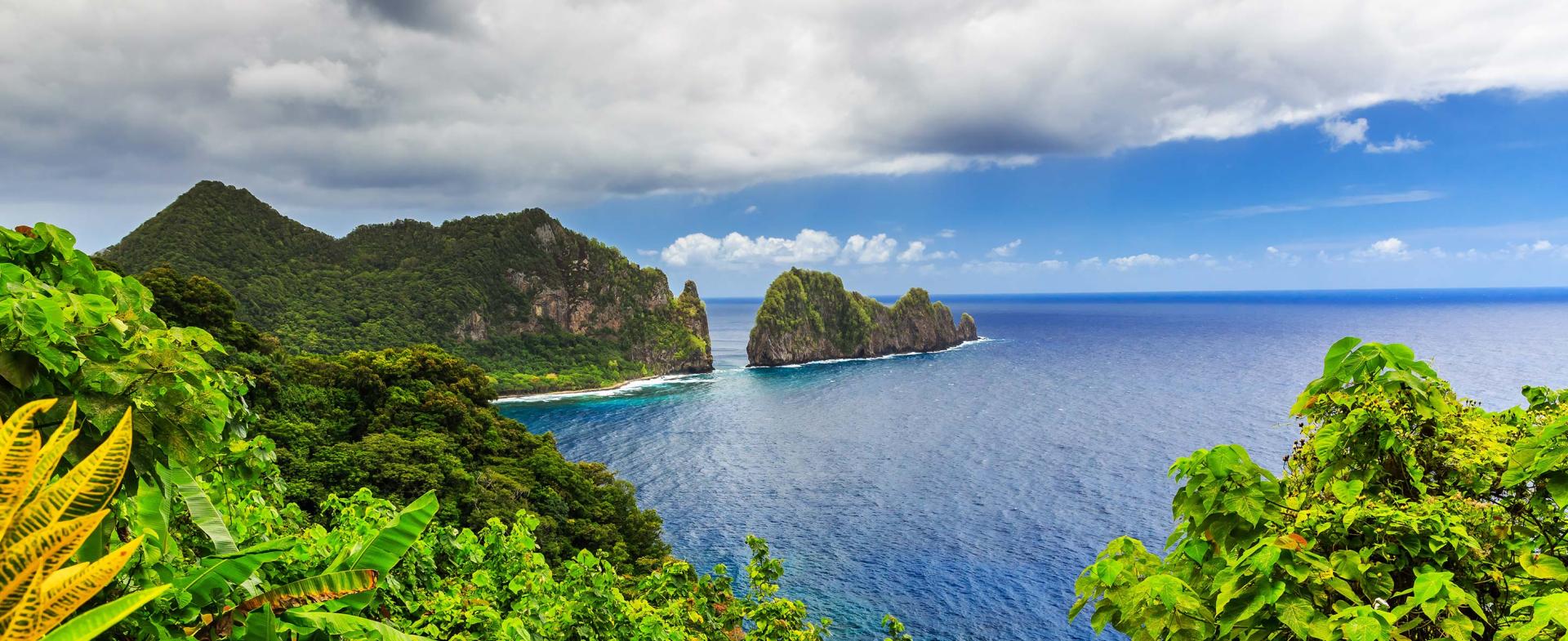

Local & Regional Drought Resources
Hawaii and USAPI Quarterly Climate Impacts and Outlook Summary
U.S. Affiliated Pacific Islands (USAPI) Drought Monitor
USDA Farm Service Agency | Hawaii and Pacific Basin
National Weather Service | Pacific Region
Pacific Drought Knowledge Exchange
WMO Region V Pacific Regional Climate Center Network
New Zealand National Institute of Water and Atmospheric Research (NIWA) Taihoro Nukurangi
Micronesia
National Weather Service Weather Forecast Office | Guam (GUM)
National Weather Service Weather Forecast Office | Chuuk
National Weather Service Weather Forecast Office | Palau
National Weather Service Weather Forecast Office | Majuro
National Weather Service Weather Forecast Office | Pohnpei/Kosrae
National Weather Service Weather Forecast Office | Yap
Polynesia
National Weather Service Weather Forecast Office | Pago Pago (PPG)
Drought in your area? Tell us how drought is impacting your community by submitting a condition monitoring report. Your submissions help us better understand how drought is affecting local conditions.
The U.S. Drought Monitor depicts the location and intensity of drought across the country. The map uses 5 classifications: Abnormally Dry (D0), showing areas that may be going into or are coming out of drought, and four levels of drought (D1–D4). The Drought Monitor focuses on broad-scale conditions. Location conditions may vary.
This map is used by the U.S. Department of Agriculture to trigger disaster declarations and loan eligibility. Individual states and water supply planning may use additional information to inform their declarations and actions.
The U.S. Drought Monitor depicts the location and intensity of drought across the country. The map uses 5 classifications: Abnormally Dry (D0), showing areas that may be going into or are coming out of drought, and four levels of drought (D1–D4). The Drought Monitor focuses on broad-scale conditions. Location conditions may vary.
This map is used by the U.S. Department of Agriculture to trigger disaster declarations and loan eligibility. Individual states and water supply planning may use additional information to inform their declarations and actions.
The U.S. Drought Monitor depicts the location and intensity of drought across the country. The map uses 5 classifications: Abnormally Dry (D0), showing areas that may be going into or are coming out of drought, and four levels of drought (D1–D4). The Drought Monitor focuses on broad-scale conditions. Location conditions may vary.
This map is used by the U.S. Department of Agriculture to trigger disaster declarations and loan eligibility. Individual states and water supply planning may use additional information to inform their declarations and actions.
Drought & Dryness Categories
No Drought
No drought or abnormally dry conditions are present, according to the U.S. Drought Monitor.
Abnormally Dry
Abnormally Dry (D0) indicates a region that is going into or coming out of drought. View typical impacts by state.
Moderate Drought
Moderate Drought (D1) is the first of four drought categories (D1–D4), according to the U.S. Drought Monitor. View typical impacts by state.
Severe Drought
Severe Drought (D2) is the second of four drought categories (D1–D4), according to the U.S. Drought Monitor. View typical impacts by state.
Extreme Drought
Extreme Drought (D3) is the third of four drought categories (D1–D4), according to the U.S. Drought Monitor. View typical impacts by state.
Exceptional Drought
Exceptional Drought (D4) is the most intense drought category, according to the U.S. Drought Monitor. View typical impacts by state.
No Data
No data are available for this location.
Drought & Dryness Categories
No Drought
No drought or abnormally dry conditions are present, according to the U.S. Drought Monitor.
Abnormally Dry
Abnormally Dry (D0) indicates a region that is going into or coming out of drought. View typical impacts by state.
Moderate Drought
Moderate Drought (D1) is the first of four drought categories (D1–D4), according to the U.S. Drought Monitor. View typical impacts by state.
Severe Drought
Severe Drought (D2) is the second of four drought categories (D1–D4), according to the U.S. Drought Monitor. View typical impacts by state.
Extreme Drought
Extreme Drought (D3) is the third of four drought categories (D1–D4), according to the U.S. Drought Monitor. View typical impacts by state.
Exceptional Drought
Exceptional Drought (D4) is the most intense drought category, according to the U.S. Drought Monitor. View typical impacts by state.
No Data
No data are available for this location.
Drought & Dryness Categories
No Drought
No drought or abnormally dry conditions are present, according to the U.S. Drought Monitor.
Abnormally Dry
Abnormally Dry (D0) indicates a region that is going into or coming out of drought. View typical impacts by state.
Moderate Drought
Moderate Drought (D1) is the first of four drought categories (D1–D4), according to the U.S. Drought Monitor. View typical impacts by state.
Severe Drought
Severe Drought (D2) is the second of four drought categories (D1–D4), according to the U.S. Drought Monitor. View typical impacts by state.
Extreme Drought
Extreme Drought (D3) is the third of four drought categories (D1–D4), according to the U.S. Drought Monitor. View typical impacts by state.
Exceptional Drought
Exceptional Drought (D4) is the most intense drought category, according to the U.S. Drought Monitor. View typical impacts by state.
No Data
No data are available for this location.
NDMC, NOAA, USDA
NDMC, NOAA, USDA
NDMC, NOAA, USDA
The U.S.-Affiliated Pacific Islands (USAPI) include three U.S. territories—American Samoa, Guam, and the Commonwealth of the Northern Mariana Islands—and three independent countries—the Federated States of Micronesia, the Republic of the Marshall Islands, and the Republic of Palau. The geology of the USAPI varies greatly—from volcanic high islands, to low coral atolls. Native ecosystems, traditional agricultural systems, hydrology, and interactions with the ocean are remarkably diverse. Droughts occur regularly and are often associated with El Niño events, which are part of a natural climate cycle in the Pacific Ocean.
The USAPI is vulnerable to the compound effects of climate change, including warming, changing drought conditions, and sea level rise, which contributes to saline contamination of freshwater supplies. Low atoll islands, where water supplies are limited to rainwater catchments, are particularly vulnerable to drought periods since water storage is often insufficient to sustain the local population. Drought in the USAPI can prompt Federal disaster declarations where residents are subject to mandatory water restrictions, and emergency deliveries of food, bottled water, and reverse osmosis pumps are required. Other impacts of drought include increased wildfire risk, negative public health and tourism impacts, loss of cultural practices, and reduced crop yields. Understanding the impacts of drought in the USAPI, summarizing the current state of the science, and improving resilience are important for successful adaptation and management.
NIDIS supports eight regional Drought Early Warning Systems (DEWS) throughout the United States. In addition, NIDIS supports states and territories outside these regions, like the USAPI, by delivering drought early warning information through Drought.gov; investing in drought research to address key scientific and societal needs; and supporting the development of new tools and products that serve the entire nation.


